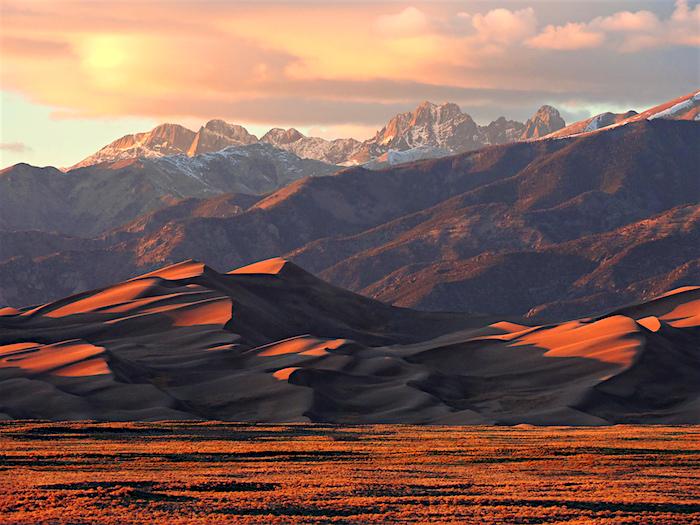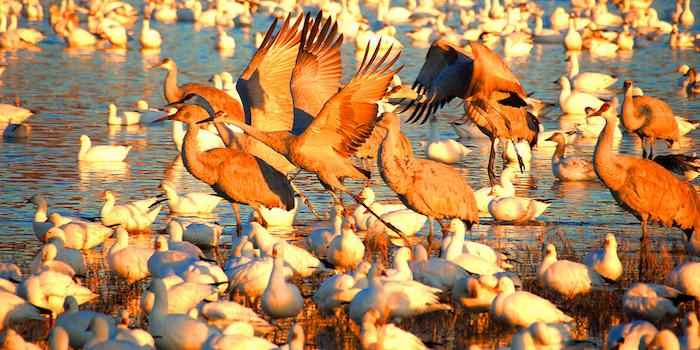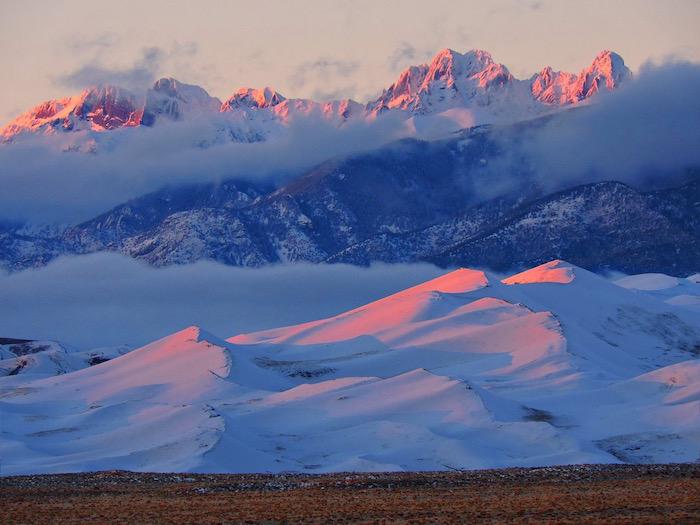
Great Sand Dunes National Park and Preserve offers an incredible mix of dunes and peaks/NPS, Patrick Myers
Somebody asks you to name the national park with the most impressive sand dunes, and you quickly answer, "Death Valley National Park!" And, of course, you'd be wrong.
While Death Valley certainly has some impressive dune fields, they pale in size and scope to those in Great Sand Dunes National Park and Preserve in Colorado. There the dunes rise taller than 70-story buildings (yep, above 700 feet), and sprawl beneath the snow-capped Sangre de Cristo Mountains, which soar to more than 13,000 feet and include some patches of tundra.
It's quite the contrast. We often point to Olympic National Park on the Washington state peninsula as three parks in one, thanks to its alpine, rain forest, and sea coast expanses.
Great Sand Dunes can be viewed in much the same biologically diverse way, with its dune fields, mid-mountain forests of aspen, Ponderosa pine, sub-alpine forests, and tundra. And when you span such a range of ecotones, you encounter a range of wildlife, from the Great Sand Dunes Tiger Beetle and kangaroo rat along the park's basement to black bears, colorful Western tanagers, and even some Rio Grand Cutthroat trout as you head up through the riparian zone, and towards the roof you could spot mountain lions, mule deer, turkeys, and even bighorn sheep.
While you won't find any moose in the park, you might come across elk as well as -- brace yourself -- bison, which have been residents of The Nature Conservancy's Medano Ranch for some time and which is expected to be transferred to the park. Bison from the ranch, which is surrounded by the park, have been known to wander into it.
So, yes, along with having North America's tallest sand dunes, this national park has quite a collection of wildlife for spotting and photographing. And, of course, it has much more than that.
Studies a decade ago demonstrated that Great Sand Dunes has one of the quietest soundscapes in the entire country. The National Park Service’s Natural Resource Program Center measured the park's soundscape back in 2008 and discovered that Great Sand Dunes is one of the quietest locations ever monitored by the natural sounds program. It’s so quiet, in fact, that it rivals the crater at Haleakala National Park, where the sound team found the natural ambient sound level so low that it didn’t register on the acoustical monitoring equipment.

Sandhill cranes and snow geese are just some of the wildlife you might encounter at Great Sand Dunes National Park and Preserve/NPS, Patrick Myers
Of course, visit the park in early summer and you might hear the laughter of children of all ages splashing about Medano Creek, which starts as snowmelt high in the mountains that is funneled down along the base of the dunes.
During the summer months you also might spot "sandboarders" zooming down the dunes. It's a demanding sport, in part because you have to carry your board or sand sled up to the top of the dunes before sliding begins, and in part because sand can be abrasive, something you'll note if you fall on the way down. In summer you'll also want to avoid midday sliding adventures, as the dunes can heat up to 150 degrees, the park staff points out.
For those not crazy about playing in sand, there's still a lot of do at Great Sand Dunes. You could go for a mountain bike ride, four-wheel up Medano Pass Road (experience four-wheeling suggested, as you could encounter creeks to ford and soft sand that could bog your rig down), hunt for elk or possibly bighorn sheep in the preserve portion of the park, fish for some of those cutthroat trout (catch-and-release only), head out on horseback to explore the park and preserve, or sling a pack on your back and disappear into the backcountry for days on end.
For those not bound by school vacation schedules, fall brings rich gold to the park in the form of turning aspen and cottonwood leaves, a wonderful contrast to early season snowfall high up near the roof of the park.
Want to have the park pretty much to yourself? Consider a January visit. In January 2018 just 3,551 folks visited the park, according to NPS records, and only 57 headed into the backcountry.
There is no lodging inside the park, so if you don't bring a tent or drive an RV 35 feet or shorter to stay in the Piñon Flats Campground, you'll have to look to the surrounding communities for a bed. There are a handful of motels in the immediate area, and if cost is no issue, the Zapata Ranch can offer an elegant ranch vacation, though rates quickly climb past $300 a night per person.
Make the trek to Great Sand Dunes just about any month of the year you won't be disappointed. In fact, you're likely to be amazed by the diversity that this park adds to the National Park System!

Winter, though cold and possibly snowy, can be a sublime time at Great Sand Dunes National Park and Preserve/NPS, Patrick Myers



Add comment